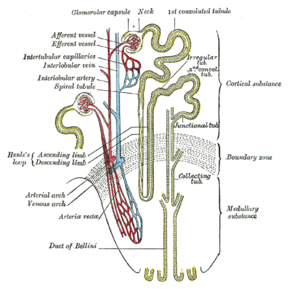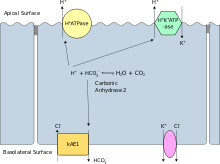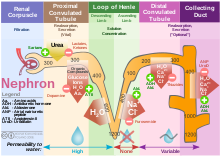Collecting duct system
| Collecting duct system | |
|---|---|
 Scheme of renal tubule and its vascular supply. | |
| Details | |
| Location | Kidney |
| Identifiers | |
| Latin | tubulus renalis colligens |
| MeSH | D007685 |
| FMA | 265239 |
| Anatomical terminology | |
The collecting duct system of the
There are several components of the collecting duct system, including the connecting tubules, cortical collecting ducts, and medullary collecting ducts.
Structure
Segments
The segments of the system are as follows:
| Segment | Description |
|---|---|
connecting tubule |
Connects distal convoluted tubule to the cortical collecting duct |
| initial collecting tubule | Before convergence of nephrons |
| cortical collecting ducts | Receives filtrate from the initial collecting tubules, and descends into the renal medulla, forming medullary collecting ducts |
| medullary collecting ducts | |
papillary ducts |
Connecting tubule
With respect to the
The connecting tubule derives from the
The initial collecting tubule is a segment with a constitution similar as the collecting duct, but before the convergence with other tubules.
The "cortical collecting ducts" receive filtrate from multiple initial collecting tubules and descend into the renal medulla to form medullary collecting ducts.
It participates in the regulation of
Medullary collecting duct
"Medullary collecting ducts" are divided into outer and inner segments, the latter reaching more deeply into the medulla. The variable reabsorption of water and, depending on fluid balances and hormonal influences, the reabsorption or secretion of sodium, potassium, hydrogen and bicarbonate ion continues here. Urea passively transports out of duct here and creates 500mOsm gradient.
The outer segment of the medullary collecting duct follows the cortical collecting duct. It reaches the level of the renal medulla where the
The inner segment is the part of the collecting duct system between the outer segment and the papillary ducts.
Papillary duct
Papillary (collecting) ducts are anatomical structures of the
The cells that comprise the duct itself are similar to rest of the collecting system. The duct is lined by a layer of
These cells work in tandem to reabsorb water, sodium, and urea and secrete acid and potassium. The amount of reabsorption or secretion that occurs is related to needs of the body at any given time. These processes are mediated by
Cells
Each component of the collecting duct system contains two cell types, intercalated cells and a segment-specific cell type:
- For the tubules, this specific cell type is the connecting tubule cell
- For the collecting ducts, it is the principal cell. The inner medullary collecting ducts contain an additional cell type, called the inner medullary collecting duct cell.
Principal cells
The principal cell mediates the collecting duct's influence on sodium and potassium balance via
Intercalated cells

Intercalated cells come in α, β, and non-α non-β varieties and participate in acid–base homeostasis.[12][13]
| Type of cell | Secretes | Reabsorbs |
| α-intercalated cells | H+/K+ exchanger) in the form of hydrogen ions |
Cl−/HCO3− exchanger)[14]
|
| β-intercalated cells | bicarbonate (via Cl−/HCO3− )
|
acid (via a basal H+-ATPase) |
| non-α non-β intercalated cells | - |
For their contribution to acid–base homeostasis, the intercalated cells play important roles in the kidney's response to acidosis and alkalosis. Damage to the α-intercalated cell's ability to secrete acid can result in distal renal tubular acidosis (RTA type I, classical RTA)(reference). The intercalated cell population is also extensively modified in response to chronic lithium treatment, including the addition of a largely uncharacterized cell type which expressed markers for both intercalated and principal cells.[17][18]
Function

The collecting duct system is the final component of the kidney to influence the body's electrolyte and fluid balance. In humans, the system accounts for 4–5% of the kidney's reabsorption of sodium and 5% of the kidney's reabsorption of water. At times of extreme dehydration, over 24% of the filtered water may be reabsorbed in the collecting duct system.
The wide variation in water reabsorption levels for the collecting duct system reflects its dependence on hormonal activation. The collecting ducts, in particular, the outer medullary and cortical collecting ducts, are largely impermeable to water without the presence of
- In the absence of ADH, water in the renal filtrate is left alone to enter the urine, promoting diuresis.
- When ADH is present, aquaporins allow for the reabsorption of this water, thereby inhibiting diuresis.
The collecting duct system participates in the regulation of other electrolytes, including chloride, potassium, hydrogen ions, and bicarbonate.
An extracellular protein called hensin (protein) mediates the regulation of secretion of acid by alpha cells in acidosis, and secretion of bicarbonate by beta cells in alkalosis.[19][20]
Collecting duct carcinoma
Carcinoma of the collecting duct is a relatively rare subtype of renal cell carcinoma (RCC), accounting for less than 1% of all RCCs.[21][22] Many reported cases have occurred in younger patients, often in the third, fourth, or fifth decade of life.[23] Collecting duct carcinomas are derived from the medulla, but many are infiltrative, and extension into the cortex is common.[24] Most reported cases have been high grade and advanced stage and have not responded to conventional therapies.[23][25] Most patients are symptomatic at presentation.[26] Immunohistochemical and molecular analyses suggest that collecting duct RCC may resemble transitional cell carcinoma, and some patients with advanced collecting duct RCC have responded to cisplatin- or gemcitabine-based chemotherapy.[27][28]
See also
References
- PMID 513494.
- OCLC 787843894.
- ISBN 0-07-135728-9.
- ISBN 1-4160-2328-3.
- ISBN 9780071807203.
- ^ ISBN 9780071807203.
- ISBN 9781451113433.)
{{cite book}}: CS1 maint: location (link - ISBN 9781451187953.)
{{cite book}}: CS1 maint: location (link - PMID 9402082. Retrieved 21 November 2017.
- ^ ISBN 0-7216-0240-1.
- S2CID 24655136.
- PMID 2526338.
- PMID 9890303.
- ^ Nosek, Thomas M. "Section 7/7ch07/7ch07p17". Essentials of Human Physiology. Archived from the original on 2016-03-24. – "Intercalated Cells"
- PMID 12217866.
- S2CID 22831140.
- S2CID 20227998. Archived from the original(PDF) on 2019-02-19.
- PMID 29667915.
- OCLC 1029074059.)
{{cite book}}: CS1 maint: location missing publisher (link) CS1 maint: others (link - PMID 8941650.
- ^ Kennedy et al., 1990[full citation needed]
- ^ Rumpelt et al., 1991[full citation needed]
- ^ a b Carter et al., 1992[full citation needed]
- ^ Pickhardt et al., 2001[full citation needed]
- ^ Chao et al., 2002b[full citation needed]
- ^ Tokuda et al., 2004[full citation needed]
- ^ Milowsky et al., 2002[full citation needed]
- ^ Peyromaure et al., 2003[full citation needed]
![]() This article incorporates text in the public domain from page 1223 of the 20th edition of Gray's Anatomy (1918)
This article incorporates text in the public domain from page 1223 of the 20th edition of Gray's Anatomy (1918)
External links
- Histology at KUMC epithel-epith04 "Collecting Duct (Kidney)"
- Histology image: 15803loa – Histology Learning System at Boston University – "Urinary System: kidney, medulla, collecting duct and ascending tubule"
- Histology image: 16013loa – Histology Learning System at Boston University – "Urinary System: kidney, H&E, collecting duct and ascending tubule"
- Nosek, Thomas M. "Section 7/7ch03/7ch03p18". Essentials of Human Physiology. Archived from the original on 2016-03-24.
- Types of tubules at ndif.org
- Diagram (#31) at benet.org
